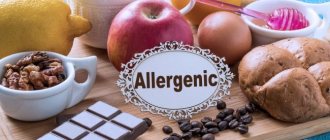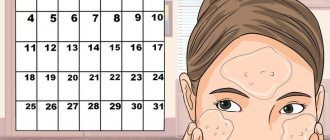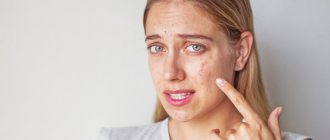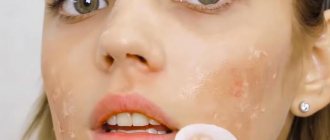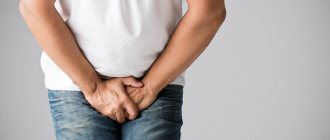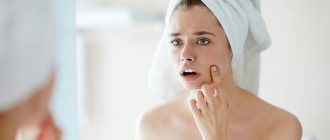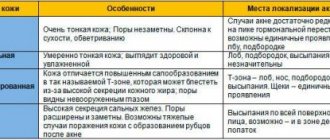A common cause of acne in women is hormonal disorders associated with diseases of the ovaries or adrenal glands. An excess of male hormones - androgens - is responsible for a number of unfavorable changes, including the development of acne.
With hormonal acne, women develop numerous purulent rashes on the neck, face and chin. Ulcers are difficult to treat. Treatment for acne caused by disruption of the endocrine system in women after thirty involves the use of creams, ointments, and sometimes hormonal drugs.
Acne after thirty. How do they manifest themselves and what is the reason?
The content of the article
Acne most often develops during puberty. These are the so-called juvenile acne. Their appearance is also associated with hormonal fluctuations, so as soon as the hormonal storm subsides, acne goes away.
Adult women and men also often come to dermatology offices with this problem. At the same time, patients who did not complain about skin problems in adolescence usually do not understand the reasons for the occurrence of purulent rashes and think that they have become infected with something. In fact, the appearance of acne was again triggered by hormones, but this is a disorder, not a natural process. In this case, you should not expect miracles in the form of independent normalization of hormonal levels. Acne in adults requires treatment.
Hormonal acne in women usually occurs on the face, chin, back and in the nasolabial triangle. Less commonly, changes in the skin appear in the lower jaw segment and on the neck. In turn, typical acne most often appears on the forehead and temples. Acne often appears suddenly, taking on the appearance of constantly incessant inflammatory changes.
The formation of acne is associated with improper differentiation of epidermal cells, the proliferation of bacteria, and also with an increased amount of sebum. Sebum production is regulated by the hormone testosterone, which is secreted by the adrenal glands in both women and men, or more precisely, by its active form, dihydrotestosterone. The activity of this hormone is determined by the presence of a special enzyme located in the skin, and the condition of the skin, in turn, depends on many environmental factors.
Among the most important causes of hormonal acne are poor diet, environment, and chronic stress.
Bacterial infection of the deep layer of skin
Occurs when microbes enter deep into the dermis.
Furuncle
First, a painful node appears, then an abscess matures in its center. After 5–7 days it opens, a purulent-necrotic core is released, and the wound is scarred. When there is more than one lesion, they speak of furunculosis.
Carbuncle
These are several boils united into a common infiltrate. The place looks like a purple-bluish tumor. Pain increases, well-being suffers, body temperature rises. After opening the formation, a deep ulcer remains, healing with a scar.
Acne (blackheads)
- inflammation of the sebaceous gland ducts due to blockage. Pustules form on the face, chest, and shoulders. Their contents dry out to crusts, after which, when rejected, scars or bluish spots remain.
Hidradenitis
Purulent inflammation of the sweat glands. The process often recurs. Favorite localizations are armpits, inguinal folds, under the mammary glands. Deep painful nodes appear, bluish-red on the outside. They are opened with the separation of liquid pus.
Erysipelas
Occurs in people who are individually predisposed. Foci of inflammation are clearly limited. The affected area is swollen, hot, bright red, with bursting blisters. The disease is accompanied by fever, intoxication, and severe pain.
Deep pyoderma can be complicated by inflammation of the lymphatic vessels and nodes, abscess, and sepsis.
Development of acne as a consequence of endocrine disorders
Acne after thirty mainly affects women. As a result of disruption of the endocrine system in the body, patients experience an increased amount of androgens, the so-called male sex hormones. This factor causes acne.
In addition to acne, women develop hyperandrogenism, which is manifested by seborrhea and hirsutism, that is, hair growth in places typical of men, male pattern baldness, and sometimes even a deepening of the voice. These disorders lead to so-called masculinization.
Hirsutism
The production of excessive androgens in women may be adrenal or ovarian. In the first case, hyperandrogenism is caused by congenital adrenal hyperplasia or the formation of hormonally active adrenal tumors that intensively produce hormones. This condition is quite rare.
Typically, hyperandrogenism is associated with excess production of androgens by the ovaries, most often caused by polycystic ovary syndrome. This disease is a rather complex problem in gynecological endocrinology, which affects about 10-15% of women of childbearing age.
The content of androgens in the body is determined using laboratory tests. Women are also characterized by rare ovulations or even their complete absence, which often makes it difficult to get pregnant.
It is important to remember that the most common manifestation of hormonal imbalance is irregular menstruation. If this symptom occurs, you should always consult an endocrinologist.
Why do acne appear on my chest*?
There may be several reasons for the appearance of acne* on the chest [4, 50, 29]:
- Hormonal imbalance. The presence of gynecological diseases, puberty in adolescents, and certain periods of the menstrual cycle cause a surge of hormones that provoke rashes.
- Poor nutrition. Although the influence of nutritional factors on the formation of acne does not have reliable evidence, there is an opinion that some products can indirectly provoke an exacerbation of acne. In particular, these include milk, cakes, sweets, fatty, salty foods.
- Wearing tight, uncomfortable clothing. Rashes may occur on the chest due to wearing synthetic clothing, which does not allow the skin to breathe and increases sweating. Rashes can also appear due to constant rubbing or squeezing.
- Cosmetics with comedogenic ingredients. Its use leads to clogged pores and the development of acne.
Acne occurs for various reasons - heredity, mechanical stress, long-term use of certain medications, stress [4, 50, 29]. Before treating acne* on the chest, you must be examined by a specialist.
How to treat hormonal acne in women
Acne caused by hormonal disorders should be treated by a gynecologist-endocrinologist or endocrinologist. However, patients usually go to see a dermatologist, who often cannot determine the cause of the disease and prescribe the correct treatment.
Treatment of hormonal acne in women can be local, when medications are applied directly to the affected areas of the skin, or systemic, using oral medications.
To relieve inflammation, experts recommend the use of antibiotics. A gynecologist-endocrinologist, after an appropriate examination, especially in pronounced cases of the disease, initiates hormonal treatment using hormonal contraceptive pills. Of course, it is used in women after twenty years, when puberty and restructuring of the body have completely occurred.
Hormonal birth control pills
Drugs are selected individually, taking into account hormonal imbalance, age, and concomitant diseases. The duration of administration is also regulated by the doctor.
To treat severe acne, a powerful drug containing a vitamin A derivative, isotretinoin, is used. Isotretinoin tablets should be taken only as directed and under the supervision of a physician; they are toxic and therefore are not intended for self-medication. Produced under the trade names: Roaccutane, Acnecutane.
During treatment, it is imperative to use contraception (hormonal or mechanical) both before and after the start of therapy, since the drugs have a teratogenic effect on the fetus.
Décolleté Pimples: Best Home Remedies for Treatment
Lemon
To fight bacteria associated with acne, you can also use lemon due to its antibacterial property. Additionally, L-ascorbic acid in lemon juice works as a natural astringent that helps dry out acne.
Cut a lemon in half and rub it on the acne-affected décolleté Allow the juice to sit on the skin for about 30 minutes Rinse the area thoroughly with cold water Try using this remedy once a day.
Alternatively, you can prepare a solution with equal amounts of lemon juice and rose water. Apply it to the affected area and keep it for 15 to 20 minutes. Finally, rinse the treated skin area with cool water. Repeat this procedure twice a day.
Note: Those with very sensitive skin should not use lemon based acne products.
Tea tree oil
Tea tree oil is another natural home remedy that can heal acne quickly. As a powerful antiseptic, this essential oil helps unclog pores and speed up the healing process.
It also helps kill bacteria responsible for acne breakouts.
A 2007 study published in the Indian Journal of Dermatology, Venereology and Leprology reported that natural 5 percent tea tree oil was effective in treating mild to moderate acne.
- Place 1 or 2 drops of tea tree oil on a cotton swab.
- Apply the oil to the affected skin.
- Let it soak in for 10 minutes, then rinse it off with warm water.
- Repeat this procedure 2 or 3 times a day.
Note: If you have sensitive skin, dilute tea tree oil with a few drops of olive oil before using it for décolleté acne.
Toothpaste
The white toothpaste you use to brush your teeth is also very effective in getting rid of acne. Its antibacterial properties help get rid of acne-causing bacteria.
Toothpaste also works to dry out blackheads caused by over-producing oil seals.
- Apply some white toothpaste to the affected area.
- Leave this overnight.
- The next morning, wash it with cold water.
- Repeat the process daily until the pimples are completely gone from your skin.
Evidence of the effectiveness of toothpaste for acne and instructions for using the product!
Aloe vera
Aloe vera is extremely effective in combating all types of acne, including the décolleté area.
The gel contains anthraquinones and flavonoids, which help dry out pimples quickly. This, in turn, helps speed up the healing process.
Aloe vera also helps relieve the itching, pain and redness associated with acne and reduces the risk of scarring.
- Open the aloe vera leaf and pour fresh gel from it into the container.
- Apply this gel to your acne.
- Rub it on the skin and leave it for a while so that the gel can penetrate deep into the skin.
- Let it dry on its own.
- Repeat the procedure 2 or 3 times a day until the acne is completely healed.
Cinnamon
Cinnamon is also effective for getting rid of acne, mainly due to its antimicrobial properties. This can help fight bacteria that cause acne.
- Mix ½ teaspoon cinnamon powder and a little honey to make a paste Apply the paste to the zit and leave it for 15 minutes Wash it completely and dry it Repeat this procedure twice a day.
- Alternatively, mix 1 tablespoon of cinnamon powder and 3 tablespoons of freshly squeezed lemon juice. Apply a thin layer of the mixture to the affected skin. Keep it on for about one hour. Wash the skin with cool water. Do this once a day.
Acne skin care
In addition to a visit to a gynecologist-endocrinologist who will prescribe appropriate hormonal treatment, proper daily skin care for acne is very important:
- Choose a good acne treatment cream
. Preparations containing salicylic acid, alpha hydroxy acids, lactic, glycolic or azelaic acid have antimicrobial, anti-inflammatory, exfoliating and healing properties. - Thorough facial cleansing is necessary
. Using makeup removers alone is not enough; you also need to wash your face with plain water, toner or micellar liquid. After properly cleaning the skin, the cotton swab should be completely clean. - Use exfoliating products.
Peels are the most recommended. As a rule, one procedure per week is sufficient. However, peeling should not be used by people with delicate, sensitive skin as it may cause irritation. - Limit decorative makeup.
It is not recommended to use a thick layer of foundation and powder, which additionally blocks the openings of the sebaceous glands and increases inflammatory changes in the skin.
It is important to remember that treating acne in adults is a long and difficult journey, so you should be patient and work on leading a healthy lifestyle. The condition of the whole organism depends on how we live. Regular exercise, quitting smoking, and a well-balanced diet provide invaluable assistance in the process of acne therapy.
Proper nutrition
First aid measures
If rashes appear, accompanied by severe itching or burning, you should consult a doctor to determine the exact cause of acne and conduct the necessary examinations.
First aid to reduce skin symptoms:
- Spot treatment of pimples. You can use calendula infusion or salicylic acid.
- For subcutaneous pimples, lubricate them with antibacterial ointment at night or make a compress to quickly ripen the comedones.
- The inflammatory process decreases after using pharmaceutical ointments (Baziron, Skinoren).
- You can make lotions from a solution with sea salt or apply aloe leaves to them.
